ESP MITSUBISHI ASX 2017 (in English) User Guide
[x] Cancel search | Manufacturer: MITSUBISHI, Model Year: 2017, Model line: ASX, Model: MITSUBISHI ASX 2017Pages: 458, PDF Size: 22.98 MB
Page 80 of 458

3.Retract the seat belt and remove it from
the seat belt guide (A).
4. After the seat belt is retracted complete-
ly, insert the latch plate (E) into the up-
per slit (H) and the latch plate (B) into the lower slit (I).
Pregnant women restraint
E00405600077WARNINGlSeat belts work for everyone, including
pregnant women. Pregnant women should
use the available seat belts. This will re- duce the likelihood of injury to both thewoman and the unborn child. The lap belt
should be worn across the thighs and as snug against the hips as possible, but not
across the waist. Consult your doctor if you have any additional questions or con-
cerns.Seat belt pretensioner
system and force limiter
system E00405700166
The driver’s seat and front passenger’s seateach have a seat belt equipped with a preten- sioner system.
Pretensioner system
E00405801135
When the ignition switch or the operation
mode is under the following conditions, if there is a frontal impact or a side impact (ve-
hicles equipped with SRS side airbags and SRS curtain airbags) severe enough to injure
the driver and/or front passenger, the preten-
sioner system will retract their respective seat belts instantaneously, thus maximizing the
seat belt’s effectiveness.
[Except for vehicles equipped with keyless operation system]
The ignition switch is in the “ON” or
“START” position.
[Vehicles equipped with keyless operation system]
The operation mode is in ON.
WARNINGl To obtain the best results from your pre-
tensioner seat belt, make sure you have adjusted your seat correctly and wear your seat belt properly.
Pregnant women restraint
4-14OGAE17E2Seat and seat belts4
Page 91 of 458

The SRS airbags are designed to supplementthe primary protection of the driver and front
passenger side seat belt systems by providing those occupants with protection against headand chest injuries in certain moderate-to-se- vere frontal collisions.
The SRS driver’s knee airbag (if so equip-
ped) is designed to supplement the primary
protection of the driver’s seat belt system. It can reduce the forward movement of the
driver’s lower legs and provide increased overall body protection in certain moderate-
to-severe frontal collisions.
The SRS side airbags (if so equipped) are de- signed to supplement properly worn seat belts and provide the driver and front passen-
ger with protection against chest and abdo-
men injuries in certain moderate-to-severe side impact collisions.
The SRS curtain airbags (if so equipped) are
designed to supplement properly worn seat belts and provide the driver and passenger with protection against head injuries in cer-
tain moderate-to-severe side impact colli- sions.
The SRS is NOT a substitute for the seat
belts. To ensure the maximum protection dur-
ing all types of collisions and accidents, all occupants, including the passengers as well
as the driver, must wear their seat belts.How the Supplemental Re-
straint System works
E00407302883
The SRS includes the following components:
1- Airbag module (Driver)
2- Front passenger’s airbag OFF indication lamp*
3- Airbag module (Passenger)
4- Driver’s knee airbag module*
5- Front passenger’s airbag ON-OFF switch*
6- Side airbag modules*
7- Curtain airbag modules*
Only when the ignition switch or the opera- tion mode is under the following conditions,
the airbags will operate.
[Except for vehicles equipped with keyless
operation system]
The ignition switch is in the “ON” or “START” position.
[Vehicles equipped with keyless operation
system]
The operation mode is in ON.
The airbags deployment produces a sudden,
loud noise, and releases some smoke andpowder, but these conditions are not injuri-
ous, and do not indicate a fire in the vehicle. People with respiratory problems may feel
some temporary irritation from chemicals
used to produce the deployment; open the
windows after airbag deployment, if safe to do so.
Supplemental restraint system (SRS) - airbag
4-25OGAE17E2Seat and seat belts4
Page 99 of 458
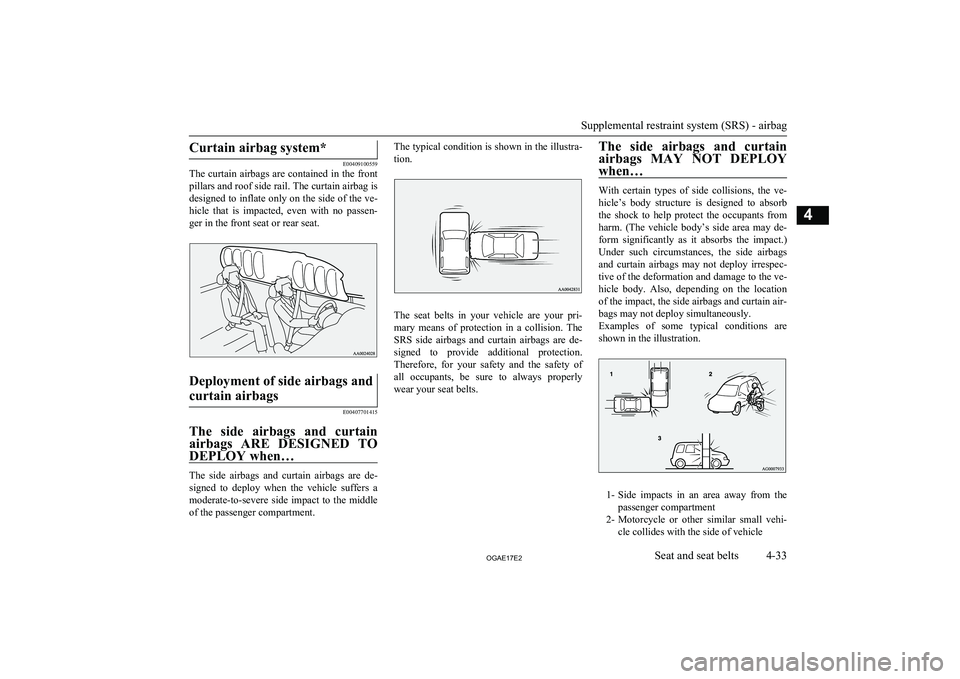
Curtain airbag system*
E00409100559
The curtain airbags are contained in the front
pillars and roof side rail. The curtain airbag is
designed to inflate only on the side of the ve- hicle that is impacted, even with no passen- ger in the front seat or rear seat.
Deployment of side airbags and
curtain airbags
E00407701415
The side airbags and curtain airbags ARE DESIGNED TO
DEPLOY when…
The side airbags and curtain airbags are de- signed to deploy when the vehicle suffers a moderate-to-severe side impact to the middleof the passenger compartment.
The typical condition is shown in the illustra-
tion.
The seat belts in your vehicle are your pri- mary means of protection in a collision. The SRS side airbags and curtain airbags are de-
signed to provide additional protection. Therefore, for your safety and the safety of all occupants, be sure to always properly
wear your seat belts.
The side airbags and curtain
airbags MAY NOT DEPLOY
when…
With certain types of side collisions, the ve- hicle’s body structure is designed to absorb
the shock to help protect the occupants from harm. (The vehicle body’s side area may de-form significantly as it absorbs the impact.) Under such circumstances, the side airbags and curtain airbags may not deploy irrespec-tive of the deformation and damage to the ve-
hicle body. Also, depending on the location
of the impact, the side airbags and curtain air-
bags may not deploy simultaneously.
Examples of some typical conditions are shown in the illustration.
1- Side impacts in an area away from the
passenger compartment
2- Motorcycle or other similar small vehi-
cle collides with the side of vehicle
Supplemental restraint system (SRS) - airbag
4-33OGAE17E2Seat and seat belts4
Page 122 of 458
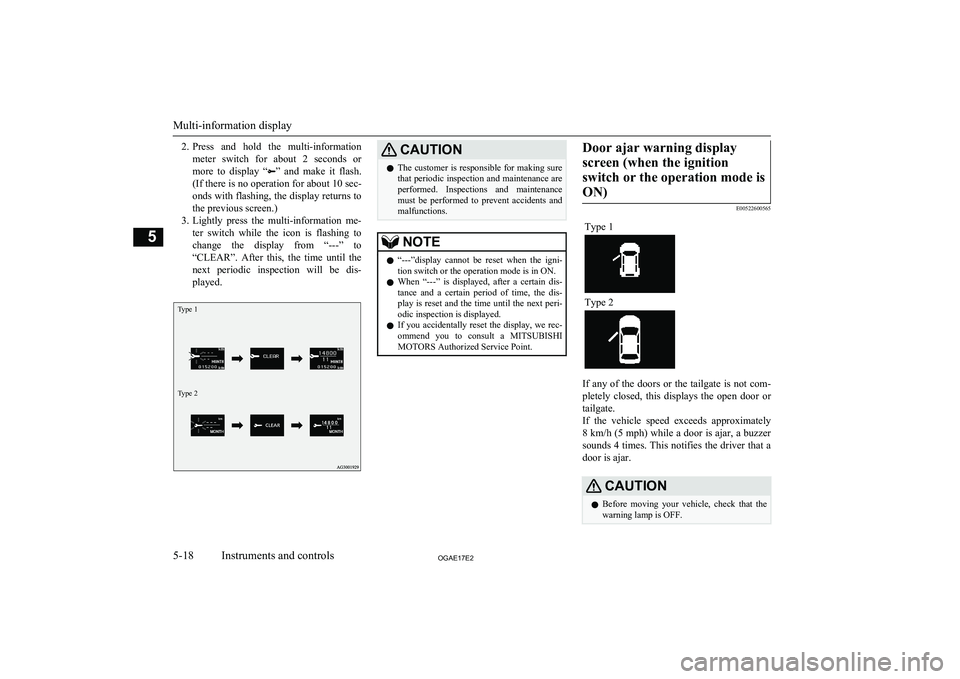
2.Press and hold the multi-information
meter switch for about 2 seconds or more to display “
” and make it flash.
(If there is no operation for about 10 sec-
onds with flashing, the display returns to the previous screen.)
3. Lightly press the multi-information me-
ter switch while the icon is flashing to
change the display from “---” to “CLEAR”. After this, the time until the
next periodic inspection will be dis- played.
Type 1Type 2
CAUTIONl The customer is responsible for making sure
that periodic inspection and maintenance are
performed. Inspections and maintenance must be performed to prevent accidents and malfunctions.NOTEl “---”display cannot be reset when the igni-
tion switch or the operation mode is in ON.
l When “---” is displayed, after a certain dis-
tance and a certain period of time, the dis-
play is reset and the time until the next peri-
odic inspection is displayed.
l If you accidentally reset the display, we rec-
ommend you to consult a MITSUBISHI
MOTORS Authorized Service Point.Door ajar warning display
screen (when the ignition switch or the operation mode isON)
E00522600565
Type 1
Type 2
If any of the doors or the tailgate is not com-
pletely closed, this displays the open door or
tailgate.
If the vehicle speed exceeds approximately 8 km/h (5 mph) while a door is ajar, a buzzer
sounds 4 times. This notifies the driver that a
door is ajar.
CAUTIONl Before moving your vehicle, check that the
warning lamp is OFF.
Multi-information display
5-18OGAE17E2Instruments and controls5
Page 150 of 458
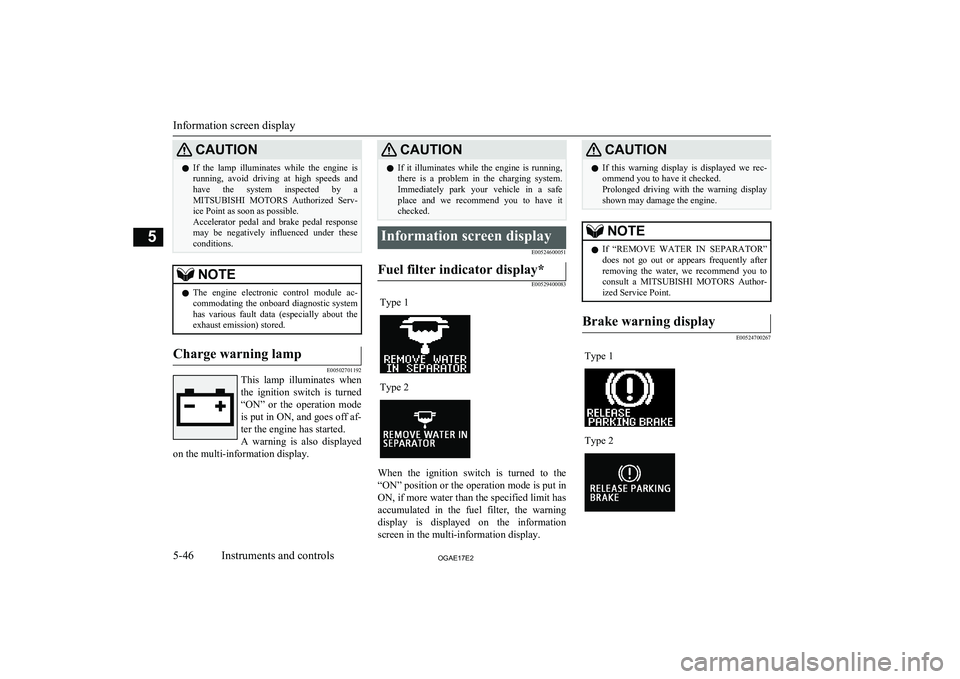
CAUTIONlIf the lamp illuminates while the engine is
running, avoid driving at high speeds and have the system inspected by a
MITSUBISHI MOTORS Authorized Serv-
ice Point as soon as possible.
Accelerator pedal and brake pedal response may be negatively influenced under these
conditions.NOTEl The engine electronic control module ac-
commodating the onboard diagnostic system has various fault data (especially about the
exhaust emission) stored.Charge warning lamp
E00502701192
This lamp illuminates when
the ignition switch is turned“ON” or the operation mode
is put in ON, and goes off af-
ter the engine has started.
A warning is also displayed
on the multi-information display.
CAUTIONl If it illuminates while the engine is running,
there is a problem in the charging system.
Immediately park your vehicle in a safe place and we recommend you to have it
checked.Information screen display
E00524600051Fuel filter indicator display*
E00529400083
Type 1Type 2
When the ignition switch is turned to the
“ON” position or the operation mode is put in
ON, if more water than the specified limit has
accumulated in the fuel filter, the warning display is displayed on the information
screen in the multi-information display.
CAUTIONl If this warning display is displayed we rec-
ommend you to have it checked.
Prolonged driving with the warning display
shown may damage the engine.NOTEl If “REMOVE WATER IN SEPARATOR”
does not go out or appears frequently after
removing the water, we recommend you to consult a MITSUBISHI MOTORS Author-
ized Service Point.Brake warning display
E00524700267
Type 1Type 2
Information screen display
5-46OGAE17E2Instruments and controls5
Page 163 of 458

NOTE•When the wipers operate at a constant in-
terval despite changes in the extent of rain.
• When the wipers do not operate even
though it is raining.
l The wipers may automatically operate when
things such as insects or foreign objects are affixed to the windscreen on top of the rainsensor or when the windscreen is frozen.
Objects affixed to the windscreen will stop
the wipers when the wipers cannot remove them. To operate the wipers again, move the
lever in the “LO” or “HI” position.
Also, the wipers may operate automatically
due to strong direct sunlight or electromag- netic wave. To stop the wipers, place thelever in the “OFF” position.
l Contact a
MITSUBISHI MOTORS Author-
ized Service Point when replacing the wind-
screen or reinforcing the glass around the sensor.To adjust the sensitivity of the rain sensor.
With the lever in the “AUTO” (rain sensor)
position, it is possible to adjust the sensitivity of the rain sensor by turning the knob (B).
“+”- Higher sensitivity to rain
“-”- Lower sensitivity to rain
NOTEl It is possible to activate the following func-
tions.
• Automatic operation (rain droplet sensi-
tive) can be changed to intermittent opera-
tion (vehicle-speed sensitive).
• Automatic operation (rain droplet sensi-
tive) can be changed to intermittent opera-
tion (except vehicle-speed sensitive).
For further information, we recommend you to consult a MITSUBISHI MOTORS Au-
thorized Service Point.Misting function
Move the lever in the direction of the arrow
and release, to operate the wipers once.
Use this function when you are driving in
mist or drizzle.
The wipers will operate once if the lever is raised to the “MIST” position and released
when the ignition switch or the operation
mode is in the “ON” or “ACC” position. The wipers will continue to operate while the lev- er is held in the “MIST” position.Wiper and washer switch
5-59OGAE17E2Instruments and controls5
Page 170 of 458
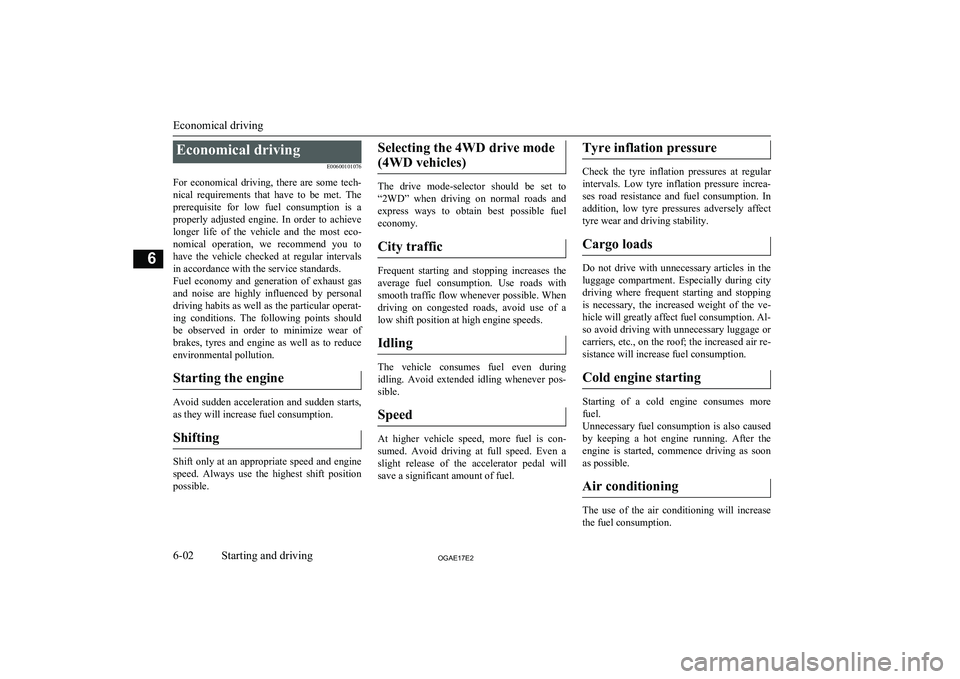
Economical drivingE00600101076
For economical driving, there are some tech- nical requirements that have to be met. Theprerequisite for low fuel consumption is a
properly adjusted engine. In order to achieve longer life of the vehicle and the most eco- nomical operation, we recommend you tohave the vehicle checked at regular intervals in accordance with the service standards.
Fuel economy and generation of exhaust gas
and noise are highly influenced by personal
driving habits as well as the particular operat- ing conditions. The following points shouldbe observed in order to minimize wear of
brakes, tyres and engine as well as to reduce
environmental pollution.
Starting the engine
Avoid sudden acceleration and sudden starts,
as they will increase fuel consumption.
Shifting
Shift only at an appropriate speed and engine speed. Always use the highest shift position
possible.
Selecting the 4WD drive mode
(4WD vehicles)
The drive mode-selector should be set to
“2WD” when driving on normal roads and
express ways to obtain best possible fuel
economy.
City traffic
Frequent starting and stopping increases the
average fuel consumption. Use roads with smooth traffic flow whenever possible. When driving on congested roads, avoid use of a
low shift position at high engine speeds.
Idling
The vehicle consumes fuel even during
idling. Avoid extended idling whenever pos- sible.
Speed
At higher vehicle speed, more fuel is con- sumed. Avoid driving at full speed. Even a
slight release of the accelerator pedal will save a significant amount of fuel.
Tyre inflation pressure
Check the tyre inflation pressures at regular
intervals. Low tyre inflation pressure increa-ses road resistance and fuel consumption. In addition, low tyre pressures adversely affect
tyre wear and driving stability.
Cargo loads
Do not drive with unnecessary articles in the
luggage compartment. Especially during city
driving where frequent starting and stopping is necessary, the increased weight of the ve-
hicle will greatly affect fuel consumption. Al-
so avoid driving with unnecessary luggage or carriers, etc., on the roof; the increased air re- sistance will increase fuel consumption.
Cold engine starting
Starting of a cold engine consumes more fuel.
Unnecessary fuel consumption is also caused by keeping a hot engine running. After the
engine is started, commence driving as soon
as possible.
Air conditioning
The use of the air conditioning will increase the fuel consumption.
Economical driving
6-02OGAE17E2Starting and driving6
Page 199 of 458

CAUTIONlIf malfunction occurs in the
A/T while driv-
ing, the warning display or the warning
display will appear on the information screen in the multi-information display.
In this case, immediately park your vehicle
in a safe place and follow these procedures:
When
warning display is showing
The automatic transmission fluid is over- heating.
Stop the vehicle in a safe place, place the se- lector lever in the “P” (Park) position, and
open the bonnet with the engine running to allow the engine to cool down.
After a while, confirm that the
warning
display is no longer showing. It is safe to
continue driving if the display is no longer showing. If the warning display remains orappears frequently, we recommend you to have your vehicle inspected.
When
warning display is showing
It may be that there is something unusual happening in the A/T, causing a safety de-
vice to activate. We recommend that you
have your vehicle inspected immediately.
Operation of the A/T
E00604200704
CAUTIONl Before selecting a gear with the engine run-
ning and the vehicle stationary, fully depressthe brake pedal to prevent the vehicle from
creeping.
The vehicle will begin to move as soon as the gear is engaged, especially when the en-
gine speed is high, at fast idle or with the air conditioning operating, the brakes should
only be released when you are ready to drive
away.
l Depress the brake pedal with the right foot at
all times.
Using the left foot could cause driver move- ment delay in case of an emergency.
l To prevent sudden acceleration, never race
the engine when shifting from the “P”
(PARK) or “N” (NEUTRAL) position.
l Operating the accelerator pedal while the
other foot is resting on the brake pedal will affect braking efficiency and may cause pre-
mature wear of brake pads.
l Use the selector lever in the correct shift po-
sition in accordance with driving conditions.
Never coast downhill backward with the se-
lector lever in the “D” (DRIVE) or sports mode position or coast forward with the se-
lector lever in the “R” (REVERSE) position.
The engine may stop and the unexpected in- crease in brake pedal effort and steeringwheel weight could lead to an accident.CAUTIONl Do not race the engine with brake pedal
pressed when the vehicle is stationary.
This can damage the A/T.
Also, when you depress the accelerator ped- al while holding down the brake pedal withthe selector lever in the “D” (DRIVE) posi-
tion, the engine revolutions may not rise as high as when performing the same operation
with the selector lever in the “N” (NEU-
TRAL) position.Passing acceleration
E00604500358
To gain extra acceleration in “D” (DRIVE)
position, push the accelerator to the floor.The A/T will automatically downshift.
NOTEl In “Sports mode”, downshifts do not take
place when the accelerator is depressed all
the way to the floor.Uphill/downhill driving
E00610500207
DRIVING UPHILL
The transmission prevents unnecessary up-
shifts even when the accelerator pedal is re- leased and ensures smooth driving.
Automatic transmission INVECS-II Sports Mode 6A/T (Intelligent & Innovative Vehicle Electronic Control System II)*
6-31OGAE17E2Starting and driving6
Page 205 of 458
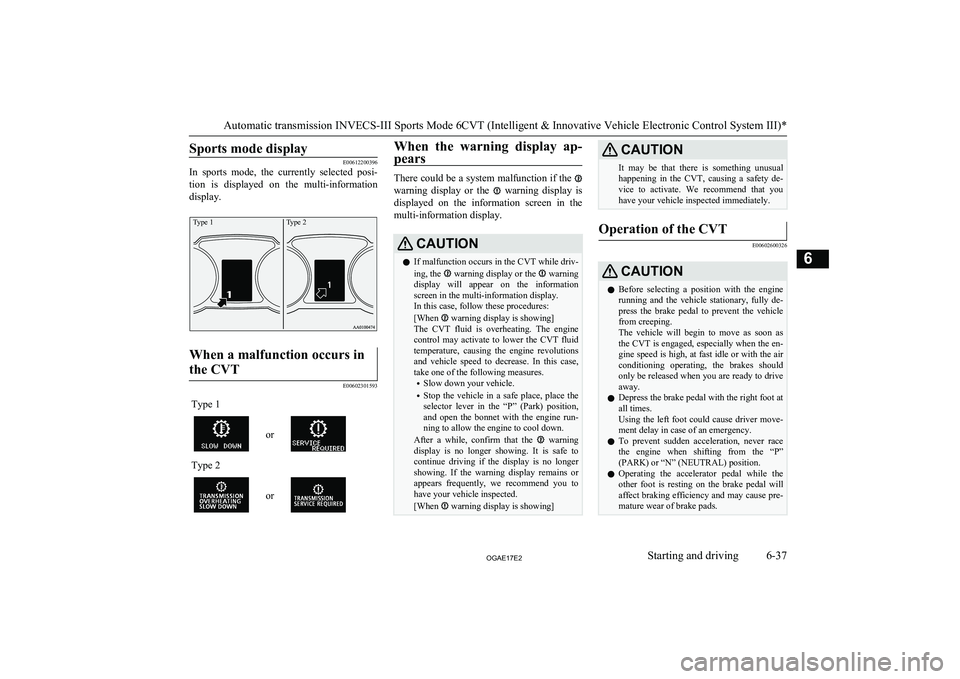
Sports mode display
E00612200396
In sports mode, the currently selected posi-
tion is displayed on the multi-information
display.
Type 1Type 2When a malfunction occurs in
the CVT
E00602301593
Type 1
or
Type 2
or
When the warning display ap-
pears
There could be a system malfunction if the
warning display or the warning display is
displayed on the information screen in the
multi-information display.
CAUTIONl If malfunction occurs in the CVT while driv-
ing, the warning display or the warning
display will appear on the information screen in the multi-information display.
In this case, follow these procedures:
[When
warning display is showing]
The CVT fluid is overheating. The engine control may activate to lower the CVT fluid
temperature, causing the engine revolutions
and vehicle speed to decrease. In this case, take one of the following measures.
• Slow down your vehicle.
• Stop the vehicle in a safe place, place the
selector lever in the “P” (Park) position,and open the bonnet with the engine run-
ning to allow the engine to cool down.
After a while, confirm that the
warning
display is no longer showing. It is safe to
continue driving if the display is no longer showing. If the warning display remains orappears frequently, we recommend you to have your vehicle inspected.
[When
warning display is showing]
CAUTIONIt may be that there is something unusual happening in the CVT, causing a safety de-
vice to activate. We recommend that you have your vehicle inspected immediately.Operation of the CVT
E00602600326
CAUTIONl Before selecting a position with the engine
running and the vehicle stationary, fully de-
press the brake pedal to prevent the vehicle from creeping.
The vehicle will begin to move as soon as
the CVT is engaged, especially when the en- gine speed is high, at fast idle or with the air conditioning operating, the brakes should
only be released when you are ready to drive
away.
l Depress the brake pedal with the right foot at
all times.
Using the left foot could cause driver move- ment delay in case of an emergency.
l To prevent sudden acceleration, never race
the engine when shifting from the “P”
(PARK) or “N” (NEUTRAL) position.
l Operating the accelerator pedal while the
other foot is resting on the brake pedal will affect braking efficiency and may cause pre-
mature wear of brake pads.
Automatic transmission INVECS-III Sports Mode 6CVT (Intelligent & Innovative Vehicle Electronic Control System III)*
6-37OGAE17E2Starting and driving6
Page 209 of 458
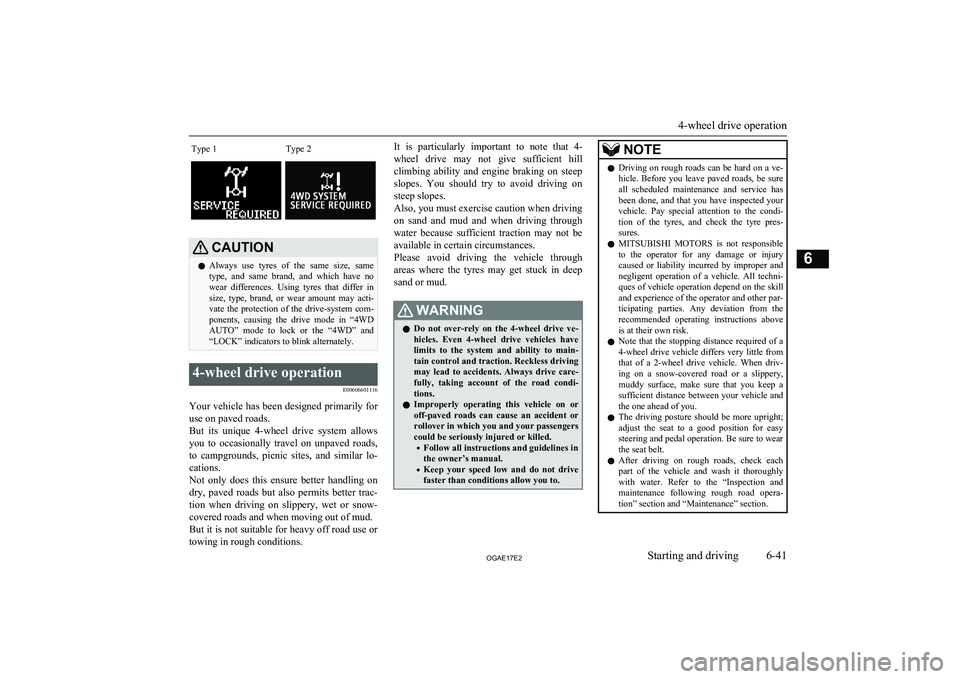
Type 1Type 2CAUTIONlAlways use tyres of the same size, same
type, and same brand, and which have no wear differences. Using tyres that differ in
size, type, brand, or wear amount may acti- vate the protection of the drive-system com-
ponents, causing the drive mode in “4WD
AUTO” mode to lock or the “4WD” and “LOCK” indicators to blink alternately.4-wheel drive operation
E00606601116
Your vehicle has been designed primarily foruse on paved roads.
But its unique 4-wheel drive system allows
you to occasionally travel on unpaved roads, to campgrounds, picnic sites, and similar lo-
cations.
Not only does this ensure better handling on
dry, paved roads but also permits better trac-
tion when driving on slippery, wet or snow- covered roads and when moving out of mud.
But it is not suitable for heavy off road use or
towing in rough conditions.
It is particularly important to note that 4-
wheel drive may not give sufficient hill
climbing ability and engine braking on steep slopes. You should try to avoid driving on
steep slopes.
Also, you must exercise caution when driving on sand and mud and when driving through water because sufficient traction may not be
available in certain circumstances.
Please avoid driving the vehicle through
areas where the tyres may get stuck in deep
sand or mud.WARNINGl Do not over-rely on the 4-wheel drive ve-
hicles. Even 4-wheel drive vehicles have limits to the system and ability to main-tain control and traction. Reckless driving may lead to accidents. Always drive care-
fully, taking account of the road condi-
tions.
l Improperly operating this vehicle on or
off-paved roads can cause an accident or
rollover in which you and your passengers
could be seriously injured or killed.
• Follow all instructions and guidelines in
the owner’s manual.
• Keep your speed low and do not drive
faster than conditions allow you to.NOTEl Driving on rough roads can be hard on a ve-
hicle. Before you leave paved roads, be sure all scheduled maintenance and service has
been done, and that you have inspected your vehicle. Pay special attention to the condi- tion of the tyres, and check the tyre pres-
sures.
l MITSUBISHI
MOTORS is not responsible
to the operator for any damage or injury caused or liability incurred by improper and
negligent operation of a vehicle. All techni- ques of vehicle operation depend on the skill and experience of the operator and other par-
ticipating parties. Any deviation from the recommended operating instructions above
is at their own risk.
l Note that the stopping distance required of a
4-wheel drive vehicle differs very little from
that of a 2-wheel drive vehicle. When driv-
ing on a snow-covered road or a slippery, muddy surface, make sure that you keep a
sufficient distance between your vehicle and the one ahead of you.
l The driving posture should be more upright;
adjust the seat to a good position for easy
steering and pedal operation. Be sure to wear
the seat belt.
l After driving on rough roads, check each
part of the vehicle and wash it thoroughlywith water. Refer to the “Inspection andmaintenance following rough road opera-
tion” section and “Maintenance” section.
4-wheel drive operation
6-41OGAE17E2Starting and driving6